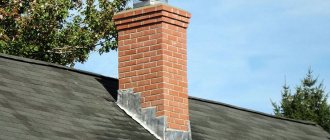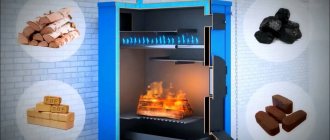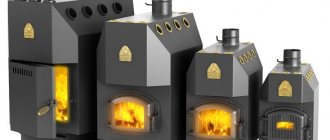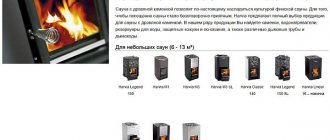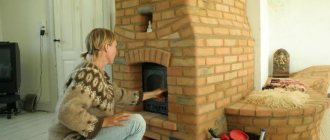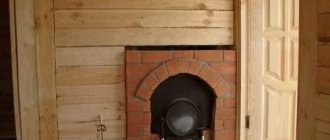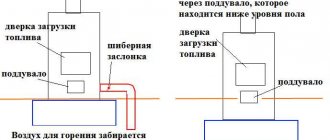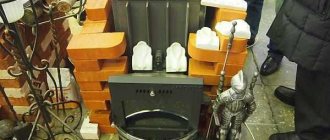Only at first glance it seems that a sauna stove is a simple structure that you can put together yourself. This will require professional skills and many years of experience.
Sometimes even a store-bought stove starts smoking after the first fire. Increased smoke in the room makes it impossible to breathe.
>
Smoking stove in a bathhouse
It is not always possible to fix the problem yourself; a complete redevelopment of the bathhouse or complex repairs may be required. The reason for the return of smoke back into the chimney and its further spread throughout the bathhouse is often due to external factors - the presence of a nearby wall or tall tree.
Backdraft - Temperature and Humidity
Why does the stove smoke into the house?
The natural extraction of flue gases through the chimney is based on the laws of physics. Of primary importance here are the temperatures indoors and outdoors, as well as the difference between them.
Poor traction is the scourge of warm weather in the off-season. For example, after a summer of inactivity, it takes special skill to light the stove in the fall so that smoke does not enter the house.
Also, the air can “stay” even in cold weather if the owners left the house and it froze. If the temperatures inside and outside are equal, there will be no draft.
Humidity can also play a role. For example, when slanting downpours occur and water enters the pipe, this upsets the temperature balance and the draft worsens.
In warm weather, or in a frozen house, paper is burned for kindling. It needs to be placed as far into the oven as possible; if this does not help, then into the far well through the cleaning door. Closer to the pipe, make a small fire made of paper or small wood chips. This is necessary in order to warm up the brick. Warm air will rise and draft will be established.
In hot weather, it is extremely difficult to establish traction.
Wind
A temporary cause of backdraft can be the wind, the direction and strength of which “drives” the smoke back into the chimney. Tall trees or buildings located near the house can contribute to this.
Install an umbrella or deflector on the top edge of the pipe. These devices significantly improve draft, protect from rain and prevent the wind from blowing smoke back into the chimney.
To date, many deflector designs have been developed. There are rotating models that are themselves installed by the force of the wind so that there is no interference with the smoke.
Many people are interested in the question: how to line an iron stove with bricks? Read useful information in our article. For information on self-repair of Ariston water heaters, see here.
Read about winter kits for air conditioners at this link.
Incorrect laying of a stove or well
An important condition for good smoke removal is sufficient chimney clearance. The pipe must be at least 15 cm in diameter (for a sauna stove - 10 cm).
During laying, the stove maker rubs the inner surface of all wells and pipes with a damp rag. If possible, all sharp internal corners are trimmed and turns are smoothed out. This creates a smooth inner surface along which smoke can easily move upward. This is done as the furnace is being laid. But you cannot plaster the inside of chimneys.
Any turn or additional well is another obstacle in the path of smoke. Therefore, the length of the pipe and its location on the roof must be adequately designed for the design of a particular stove.
It is also important that the entrance to the first well (inside the firebox) is not lower than the top edge of the door. Otherwise, there is a possibility that every time the fuel chamber is opened, smoke will flow into the room.
The stove maker's mistakes come at a cost. Something in the design can be corrected only by moving part of the stove, or maybe by completely rebuilding it.
A tall, straight pipe with a smooth inner surface can be a salvation if minor miscalculations are made and the draft is weak:
- If located close to the ridge, the pipe should be at least 50 cm higher than it.
- When located 1.5 - 3 m from the ridge, the height of the pipe is allowed to be level with the ridge or higher.
- The pipe can only be slightly lower than the ridge if it is located more than 3 m from it.
- A chimney height of 5 m or more is capable of providing full draft.
- Under no circumstances should the chimney be assembled from elements of different sections!
It is advisable to make a pipe with a round cross-section. In the corners of rectangular smoke extractors, unnecessary turbulence is created, and soot formation occurs more readily.
Metal pipes “suffer” from deteriorating traction more often than brick and asbestos pipes. This happens because the metal heats up quickly and cools down just as quickly on a frosty day. Insulation with non-flammable material saves the situation.
Rules for installing the stove
Even at the design stage of the steam room, it is necessary to purchase a stove. Depending on the features of its design, the bathhouse itself is built. In addition, the stove influences what kind of thermal insulation of the room to organize, what design to make the roof of the building, where to vent the chimney.
The stove must be installed on a reliable and fire-resistant base. It is best to install the oven on concrete. It is imperative that thermal insulation is laid in front of the stove door and covered with a metal sheet. It is strictly prohibited to place a stove near wooden walls. Usually a separate room is allocated for it.
After the stove takes its place, begin installing the chimney pipe. The best option is a straight pipe, since it provides reliable draft and there is no reason why the stove in the bathhouse smokes. The best option would be if the installation of the chimney is carried out by a specialist, since this is a rather difficult task.
Soot and furnace wear
Why does the stove smoke in a private house? Other reasons
Even if the stove was perfect at the construction stage, over time the chimney clearance may narrow due to the build-up of soot. This is an inevitable process, so the oven is cleaned regularly. However, without wanting it, owners can significantly speed up the soot formation process.
What mistakes should you avoid:
- Do not use wet firewood, especially resinous wood.
- Do not over-burn large amounts of synthetic waste in the oven (cellophane, plastic, rags, rubber...).
- During the construction stage, do everything possible to ensure that the inner surface of the stove does not have protrusions, is smooth and uniform.
- Do not try to convert a regular oven into a pyrolysis oven.
Thrifty owners often strive to do the latter in order to save money. They limit the air supply, without opening the vent, but leaving only a small gap. The result is not combustion, but smoldering and decay. But a Dutch oven or a Swedish oven will never become pyrolyzed; by their nature, they should “hum” during combustion, and the vent can only be closed when there are coals left.
Particular attention should be paid to cleaning the stove for those stoves that are regularly fired with coal. This fuel quickly leads to the pipe becoming overgrown with soot (coal, like firewood, needs to be given a sufficient amount of oxygen to allow it to flare up properly).
By the way, the fact that it’s time to clean the stove can be indicated not only by the smoke in the house, but also by the sparks flying out of the chimney into the street. This happens when combustion does not occur in a furnace, but the soot itself burns in wells.
If after cleaning, the problem with traction remains or worsens, it is possible that soot fell on some area during cleaning, and the area remained uncleaned. With an aged stove, such a nuisance may occur as part of the brick falling off, which is not noticeable from the outside.
To be sure that the wells are clean along their entire length, you can make additional holes for cleaning. This is done using a hammer drill or a drill with a Pobedit drill bit.
Presence of cracks
It's no secret that over the years the stove becomes covered with a network of cracks and cracks. Especially at the junction of clay and metal elements, for example, around a slab. Wells can also crack at the seams.
The cracks could remain in the place where a knockout brick is inserted for cleaning, or the vent and firebox doors have become loose over time.
Also, atmospheric phenomena sometimes destroy the outer part of the pipe on the roof.
It is possible and necessary to deal with cracks, because air is sucked in, its natural flow is disrupted, and at the slightest disturbance in draft for other reasons, smoke finds its way out, even with the door closed!
The cracks are sealed with clay mortar, similar to the one on which the stove is made. Deep cracks are widened using a knife or similar tool to allow the mortar to penetrate deeper between the bricks. Then the gap is moistened with water and sealed well. Small cracks can be whitened.
Minor defects on the inner surface of the walls
Have you eliminated the visible causes of smoke, but the stove still continues to smoke? Another reason for this is cracks on the walls of the chimney and combustion chamber. Cold air penetrates through these cracks, lowering the temperature level, as a result of which the stove smokes. What to do to get rid of small cracks? To do this you need:
- Clean the surface, widening the cracks with a chisel.
- Prepare a liquid primer by mixing cement with water and thoroughly coat the cracks.
- While the treated surface dries, prepare clay grout for plastering, using 2 parts clay and 1 part sand. In order to increase the strength of the mixture, add 0.1 parts of asbestos. Add as much water to the crumbly mixture as needed to achieve a thick consistency.
- The cracks are filled using a triangular trowel, the surface is leveled and rubbed with a wooden float.
- Leave the plaster and wait until it is about 80% dry.
- A finishing layer of grout is applied on top, carrying out independent repairs of the stove, moving in the direction from bottom to top.
- After waiting for the surface to dry completely, you should moisten a wooden grater in water and rub in the remaining irregularities, performing smooth circular movements.
Remember that small cracks that form in the tile cladding are rubbed with a solution based on alabaster and chalk.
Experts recommend replacing tiles with significant defects. New and intact products are placed on a solution of clay or fireclay mortar.
Ventilation
The chimney itself is a natural exhaust hood. In order to create upward movement of warm air, a full influx from the outside must be ensured.
Oven ventilation
However, often, when installing a forced ventilation system, owners only perform forced exhaust (in the kitchen and bathroom, for example). If some factors have influenced the reduction in draft in the chimney, powerful forced exhaust through a separate channel will become an additional obstacle to the normal movement of smoke from the stove.
The second floor may compete with the chimney. If there is a staircase nearby and an opening to the top, air sometimes rushes there more readily, especially if at those moments when a window on the second floor opens.
Temporarily turn off the hood, close the windows on the second floor, open a window or door at the level of the stove so that fresh air enters the room. However, the other extreme should not be allowed - drafts.
Design features
To avoid this, the following requirements are put forward for stoves intended for heating premises:
- the chimney opening should be 14 x 27 cm for wood-burning and peat stoves or 14 x 14 cm for coal stoves;
- chimney height - at least 6 cm (from the grate to the top);
- the height of the chimney above the roof is from 70 cm, but not higher than 50 cm from the end of the ridge.
An exception may be the case when the ridge is located at a distance of more than 1.5 m, then the pipe can be extended to the same height.
Other reasons
Smoke can enter the house if there is too much wood in the firebox and the entrance to the wells is blocked, and the fuel has not yet had time to ignite.
What to do here is decided according to the circumstances.
If the firewood is just starting to burn, you can carefully pull out several large logs (if they give off smoke, take them outside).
When the fuel is filled, a poker is used to try to stir up the pile and lay it down more compactly.
Many people ask the question: which brick stove to choose for a summer house when building it yourself? In our article you will find a lot of useful manufacturing options. Read about DIY waste oil stoves here.
Conclusion
So, the full list of reasons why the stove smokes is quite impressive. In each specific case, you need to consider: is this a rule or an exceptional case; what is the current weather and temperature in the house; how old is the stove and other factors.
Using the wrong type of fuel
Why does the stove smoke? A possible reason is a large temperature difference with fuel that does not match the type of stove. In coal stoves, the length of the blower is equal to the size of the firebox. If you burn wood in such a stove, the cold air that collects in the firebox does not have time to warm up and comes out through the open door, saturating the room with smoke and soot. To fix the problem, shorten the blower by placing one or more brick halves on its end (the number depends on the length of the blower).
It is important to know that smoke is often caused by improper placement of firewood inside a brick oven. If the fuel does not completely cover the grate, then the main air flows go past. As a result, cooled flue gases escape into the room. You can eliminate the problem associated with the fact that the stove smokes when lighting, by stacking the logs in even rows so that they are closely adjacent to each other.
